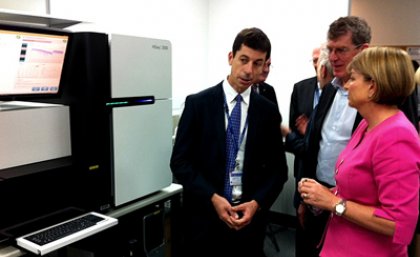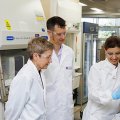
The vision of a specialised centre to better understand and treat head and neck cancers will come to fruition — thanks to $15 million funding from Atlantic Philanthropies, the Queensland Government and the Princess Alexandra Hospital.
Premier Anna Bligh announced the cutting-edge research facility this morning at The University of Queensland Diamantina Institute.
Professor Ian Frazer, Director of Research and CEO of the Translational Research Institute, said the centre would bring critical new equipment for developing tests to help treat head and neck cancers.
“The creation of this centre is a major step towards reducing deaths from these particularly unpleasant cancers,” Professor Frazer said.
Head and neck cancers have a significant impact on morbidity, mortality and health costs in Queensland and in particular, Vietnam, China and India.
The Premier said the centre aimed to deliver novel diagnostic and treatment therapies, and partnership with commercial collaborators as well as training healthcare workers in Australia and Southeast Asia.
“Men are approximately twice as likely to be diagnosed with head and neck cancer as women but every Queenslander is potentially at risk,” Ms Bligh said.
“That’s why this Centre can make such a huge difference to the lives of hundreds of Queenslanders.”
Head and neck cancers are increasing in incidence in Australia and are considered extremely difficult to treat. A group of Queensland scientists with the shared common knowledge surrounding the severity of head and neck cancers collaborated to realise the need for the Centre.
The inception of the Centre was led by chief investigator Professor Bill Coman, the visionary behind the idea.
The concept was a five-year project to better understand, prevent, diagnose and treat head and neck cancer in Australia. The Centre is a Queensland first, and one of only two in Australia.
The facility will be largely based at the Princess Alexandra Hospital and the Translational Research Institute, which is under construction and due for completion in October 2012.
The location of the new centre will allow for strengthened educational and research growth and build on the existing clinical links available at the PAH.
The centre will provide prevention through education and training for doctors, health professionals and scientists, vaccination against relevant viruses, early diagnosis using saliva tests, immunotherapy targeting EBV or HPV viruses and other viruses, and better management through accurate staging by MRI and CT scanning.
The centre also will also be home to Queensland’s first PET-MRI machine, giving doctors access to high-resolution imaging to better locate tumours and cancers.
There are three main risk groups in terms of head and neck cancers: older males with a history of smoking and alcohol consumption, younger males with oral or tonsillar HPV infection (this group is increasing substantially worldwide), and ethnic Chinese persons with EBV infection.
Lead investigators involved are Dr Chamindie Punyadeera (of the Australian Institute of Bioengineering and Nanotechnology and the UQ School of Chemical Engineering), Professor Ian Frazer (The University of Queensland, Dr Peter Parsons and Dr Chris Schmidt (both Queensland Institute of Medical Research).
“We are indebted to the Atlantic Philanthropies, the Queensland Government and the Princess Alexandra Hospital for their vision in funding this key Centre, and for the benefits it will bring not only to Queenslanders, but also to those at risk of these cancers worldwide,” Professor Frazer said.
Media: Kate Johnston, Chief Operating Officer, TRI, ph +61 7 3896 1968, kate.johnston@tri.edu.au













